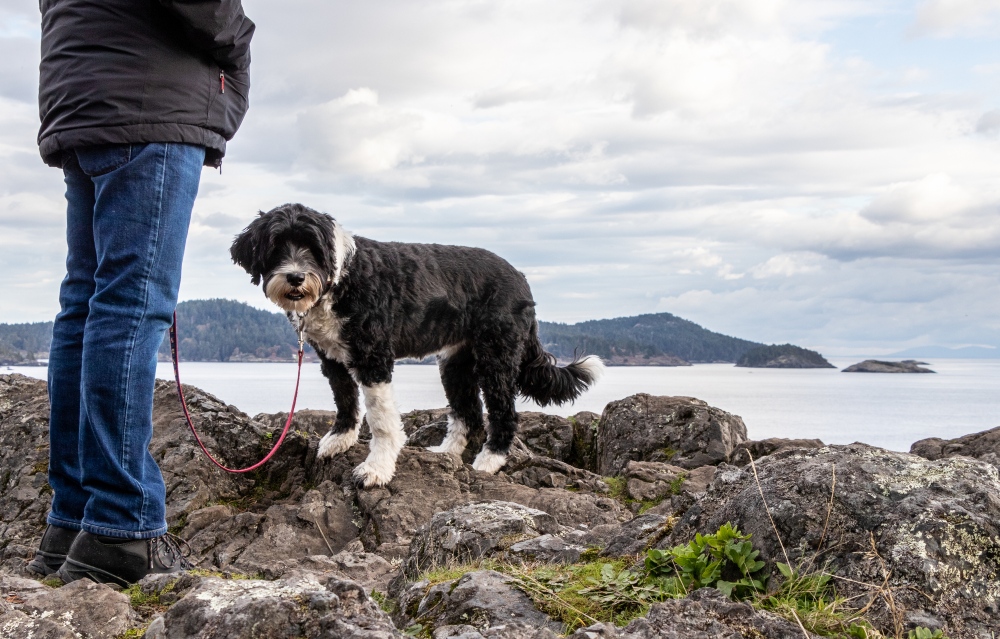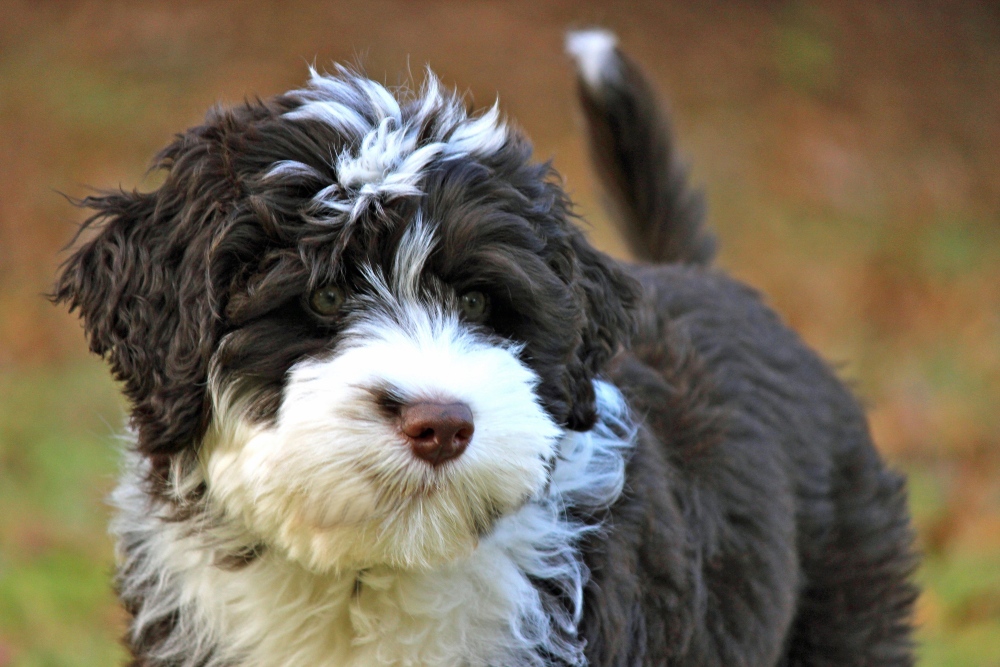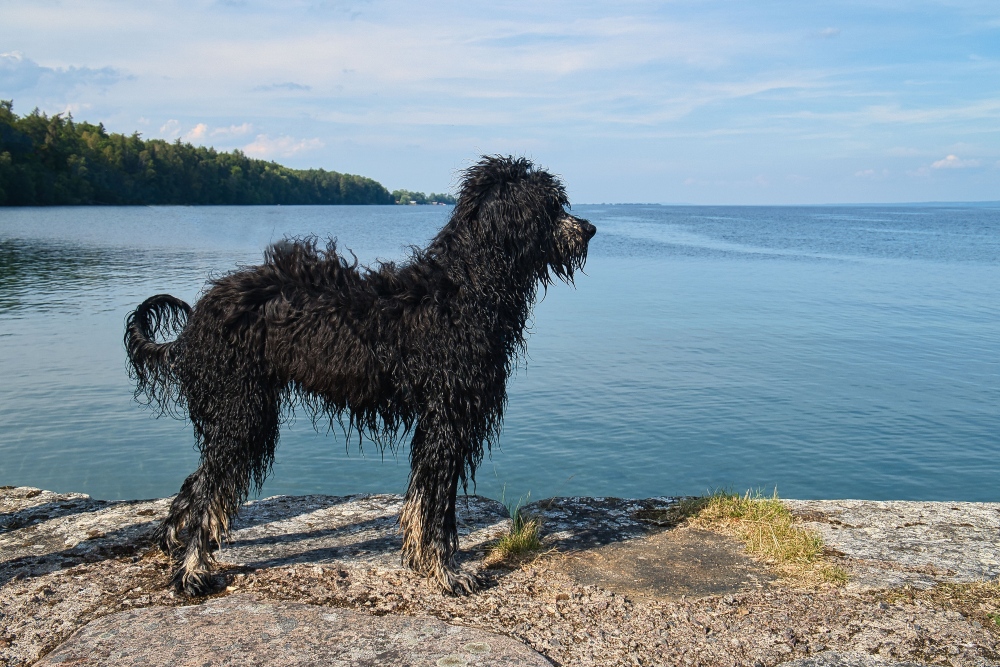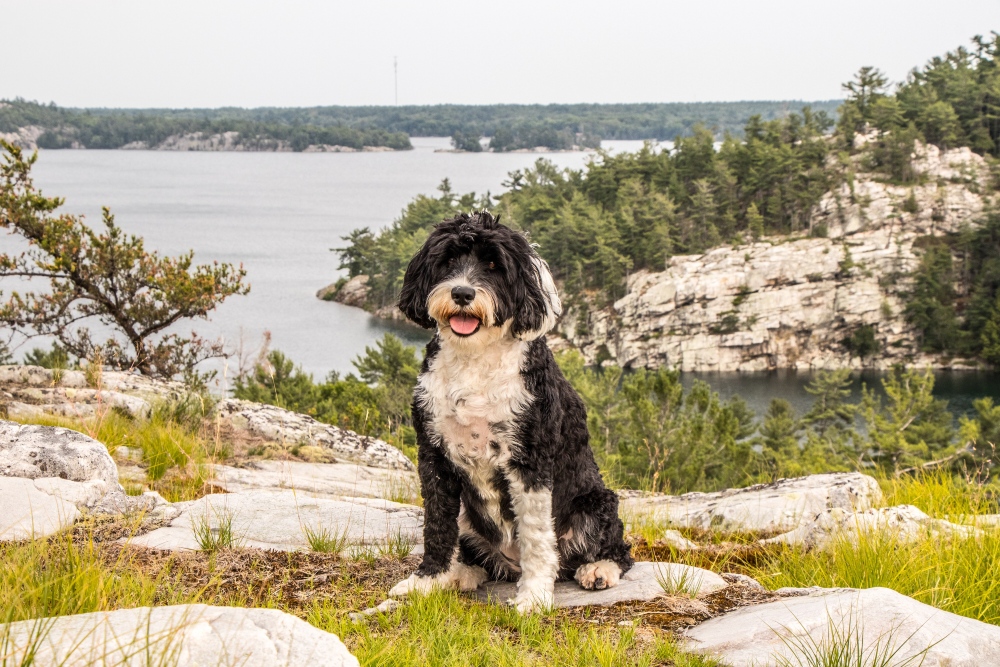Table of Contents
Introduction to Portuguese Water Dogs
As their name suggests, Portuguese water dogs are known for being an athletic and adventurous type of dog breed. These are Working Group dogs that are moderate in size and have a curly coat. Portuguese water dogs are also loyal and affectionate, which makes them excellent dogs to bring into your household as a beloved companion.
Naturally, Portuguese water dogs love water and have webbed feet that help them swim. They are also sometimes referred to as “Velcro dogs” because they become so attached to their family members. If you are curious to learn more about this unique breed, here is a breed guide with lots of information from the Healthy Paws team!
Size of Portuguese Water Dogs
The Portuguese water dog is a medium-sized dog that is an ideal size for many households. When fully grown, an adult male dog is 20 to 23 inches tall and 42 to 60 pounds. An adult female dog is 17 to 21 inches tall and 35 to 50 pounds. This breed typically stops growing by 12-18 months of age. Their minds catch up to their bodies and they become mentally mature when they are around 2 years old.
Here’s how big you can expect your Portuguese water dog to get as the dog grows from puppyhood to adulthood:
| Weight Chart | 3 months | 6 months | 9 months | 12-18 months |
| Average weight of Portuguese water dogs | 11-22 lbs. | 25-43 lbs. | 30-55 lbs. | 35-60 lbs. |

Characteristics of Portuguese Water Dogs
Portuguese water dogs are energetic dogs that do well with active families. However, they require a good amount of exercise and mental stimulation so that they don’t become bored and destructive. The breed generally gets along well with kids and other pets, especially if they are introduced to each other from an early age. Although Portuguese water dogs are often considered to be hypoallergenic, it is important to realize that all dogs can trigger allergies to some degree.
As you get to know a Portuguese water dog’s personality, here’s what you can expect based on his or her breed characteristics.
| Breed Characteristic | Level (High, Medium, Low) |
| Affectionate with People | High |
| Good with Kids | High |
| Good with Pets | High |
| Need for Exercise | High |
| Energy Level | High |
| Intelligence Level | High |
| Able to Be Trained | Medium |
| Amount of Barking | Medium |
| Amount of Shedding | Low |
History of Portuguese Water Dogs
Portuguese water dogs were initially bred to help fishermen do their work on the water in Portugal. The dogs would help retrieve gear from the water, get fish into nets, and take messages between boats while swimming between them. These early Portuguese water dogs were hardy and able to withstand the frigid waters that they traveled to off the Icelandic coast. They are hardworking dogs that nearly became extinct in the early 20th century, however, as fishing practices modernized. Dr. Vasco Bensuade, a lover of the breed and Portuguese shipping leader, worked to save the dogs’ lineage and create a breed club.
The Portuguese Water Dog Club of America formed in 1972, and their numbers gradually increased in the following years. The American Kennel Club first recognized the dogs as an official breed in 1983. Their popularity has increased because of their waterproof coat and low-shedding quality that makes them a preferred dog among people with mild dander allergies.

Portuguese Water Dog Standard Information
There are certain standards by which Portuguese water dogs are judged at shows and competitions, known as the breed standard. These dogs can be groomed in two ways, the first being the retriever clip that features the entire coat clipped to a length of one inch and the tail tip at full length. There’s also the showier lion clip that requires the coat on the muzzle and hindquarters to be clipped close to the skin.
For more information, here is an overview of the breed standard information for Portuguese water dogs:
Head:
- Large, well-proportioned head
- Medium eyes set well apart and roundish
- Black or shades of brown for eyes
- Ears set well above the line of the eyes
- Scissors or level bite
Neck, Topline, Body:
- Straight, short, and round neck held high
- Level and firm topline
- Broad and deep chest
- Long and well-sprung ribs
- Tail not docked, thick at the base and tapering
Forequarters:
- Shoulders well-inclined and strongly muscled
- Long and strong pasterns
- Dewclaws may be removed
- Feet round and flat
- Webbing of soft skin covered with hair between the toes
Hindquarters:
- Powerful and well-balanced hindquarters
- Well-developed buttocks
- No dewclaws and metatarsus long
Coat:
- Thick, strong, and covering the body evenly
- Curly coat with compact, cylindrical curls or wavy coat with gently falling waves
- Lion clip or retriever clip acceptable
Color:
- Black, white, shades of brown, or combinations of these colors
- Blueish skin with black or white coats
Gait:
- Lively steps
- Forward-striding trot
- Well-balanced movement

Caring for Portuguese Water Dogs
If you live near a safe body of water for swimming, this is an excellent dog breed for you. Portuguese water dogs also love swimming pools! They have a low prey drive but enjoy playing with toys – something good to know to prevent boredom. However, these are dogs that require a lot of grooming, so plan on scheduling a haircut at least every couple of months.
Here are some general tips for taking the best care of a Portuguese water dog:
Best Living Environments:
- Apartments are okay if the dog is properly exercised
- Homes with fenced yards are great
- A residence near a safe body of water to swim in is ideal
- Homes with children, cats, and other dogs are fine with proper training and supervision
Type of Exercise:
- Swimming and dock diving
- Hiking with family members
- At least 30 minutes to an hour of exercise daily
- Jogging with family members
- Games of fetch in a yard
Mental Enrichment:
- Toys to stimulate the dog’s mind
- Agility, tracking, and obedience training
- Food puzzles when left alone
Training Strategies:
- This breed is generally a quick learner and loves picking up new skills
- Give the dog a job to do
- Utilize only positive training techniques
Grooming Tips:
- Brush or comb two or three times per week
- Clip or trim the coat every 4-8 weeks
- Rinse coat off after swimming
- Dry out ears after swimming to prevent infection
- Brush teeth daily
- Trim nails as needed
Common Health Problems of Portuguese Water Dogs
The average life expectancy of a Portuguese water dog is 11 to 13 years. If you are considering getting a Portuguese water dog, it is a good idea to understand the potential health conditions that this breed is prone to.
These are some of the most common health issues that arise with Portuguese water dogs:
- Hip dysplasia
- Progressive retinal atrophy
- Microphthalmia syndrome
- Juvenile dilated cardiomyopathy, an inherited disease
- Storage disease (GM1), a genetic disorder that is rare now but still should be tested for
- Addison’s disease
- Allergic skin disease
- Inflammatory bowel disease
- Hypothyroidism
- Cancer

Diet and Nutrition for Portuguese Water Dogs
Most adult dogs will thrive when eating high-quality, nutritionally complete and balanced dog food. Most Portuguese water dog puppies should eat puppy food until they are 12-18 months old. If you feed your Portuguese water dog homemade food, make sure you are working from a recipe that is designed by a veterinary nutritionist and is appropriate for your dog’s age and health status.
Feed the amount of dog food needed to keep your pet slim. You should be able to see your dog’s waist and feel (but not see) their ribs without having to press too hard. In general, puppies need more calories per day than adults, but a dog’s needs will vary with his or her activity level and other factors. Don’t leave food out all day for a Portuguese water dog to graze on. Divide the total amount of food for the day into at least two meals for adults and three meals for puppies. Place the food out in a bowl at approximately the same time in the morning and evening each day.
Talk to your veterinarian if you have any questions about your Portuguese water dog’s diet or health.
Where to Adopt or Purchase Portuguese Water Dogs
You can search for purebred Portuguese water dog puppies for sale on the AKC Marketplace, and rest assured that the dog you are getting is from an AKC-registered litter and a breeder who has cared for the puppy according to established guidelines. The Portuguese Water Dog Club of America offers resources to find a breeder and rescue groups specific to this breed. Some rescue organizations to look into include the PWDCA Rescue and Mayflower Portuguese Water Dog Club. Portuguese water dogs and mixes may also be available through local shelters.
Related Breeds
The Portuguese water dog is a unique type of dog, but there are similar and related breeds that you might be interested to learn more about too. Here are some examples to consider before you make the final decision to bring a new pet into your home:
- Barbet
- Irish water spaniel
- American water spaniel
- Lagotto Romagnolo
- Boykin Spaniel
Pet Insurance for Portuguese Water Dogs
To take the best care of your Portuguese water dog’s health and enjoy peace of mind, sign your pup up for a Healthy Paws dog insurance plan. With Healthy Paws, you can rest assured that you can pay for expensive veterinary bills whenever your pup gets into an accident or becomes sick. You can visit any licensed vet you trust and enjoy the benefits of no per-incident, annual, or lifetime caps on claim payouts.
Get your Portuguese water dog health insurance quote on our website today!









